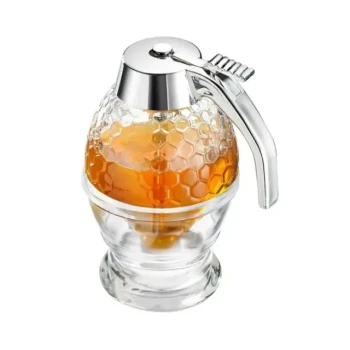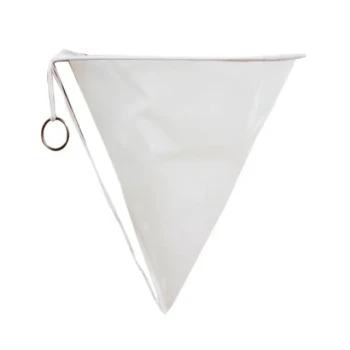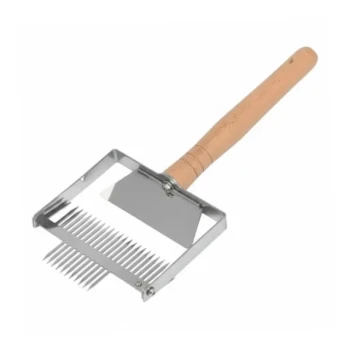In short, yes. Raw honey possesses significantly stronger and more reliable antibacterial properties than its processed counterpart. This difference is not due to a single factor but to the cumulative effect of processing, which systematically strips honey of the very components responsible for its natural medicinal qualities.
The core difference lies in a simple trade-off: processed honey sacrifices its natural antibacterial enzymes and beneficial compounds for a longer shelf life, a clearer appearance, and a more consistent texture. Raw honey retains these elements, making it a more potent functional food.
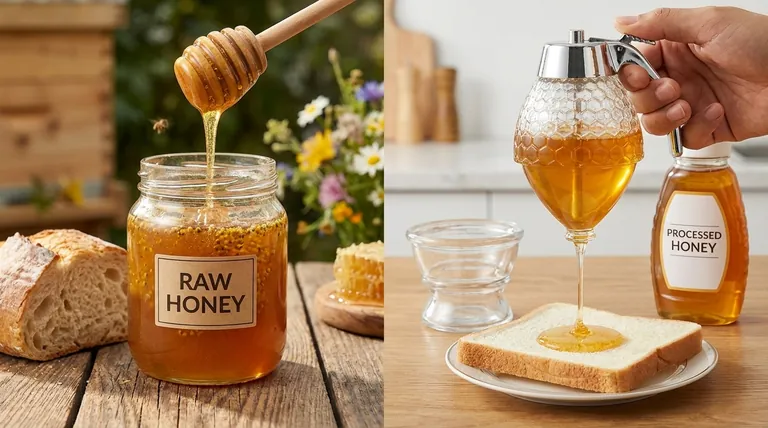
What Gives Honey Its Antibacterial Power?
To understand the difference, we must first examine the mechanisms that make honey a hostile environment for bacteria. These properties work in concert to create a powerful antibacterial effect.
The Role of Enzymes and Hydrogen Peroxide
Honey bees add an enzyme called glucose oxidase to nectar. In the presence of water, this enzyme breaks down glucose and produces small, steady amounts of hydrogen peroxide, a well-known antiseptic.
This process creates a sterile environment within the hive and is a primary source of honey's antibacterial action when used topically.
High Acidity
Honey is naturally acidic, typically with a pH between 3.2 and 4.5. This low pH is well below the level most bacteria need to grow and reproduce, effectively inhibiting their colonization.
Low Water Content
Honey has a very low water content and high sugar concentration. Through a process of osmosis, this high sugar environment draws water out of any invading microbial cells, dehydrating and killing them.
The Contribution of Pollen and Phytochemicals
Raw honey contains pollen and various phytochemicals—beneficial compounds derived from the plants the bees visited. These substances can contribute their own unique antimicrobial and antioxidant properties to the final product.
How Processing Diminishes These Properties
Commercial honey processing involves two main steps—pasteurization and filtration—both of which degrade its natural antibacterial arsenal.
The Impact of Pasteurization
Pasteurization involves heating honey to high temperatures (typically 161°F or 72°C) to kill yeast, extend shelf life, and slow crystallization.
Unfortunately, the key enzyme glucose oxidase is extremely sensitive to heat. Pasteurization effectively destroys it, eliminating honey's ability to produce hydrogen peroxide.
The Impact of Filtration
Ultra-filtration is used to remove fine particles, including pollen grains and other microscopic solids, creating the clear, smooth liquid many consumers expect.
This process removes not only the nutritional benefits of pollen but also other beneficial compounds that contribute to honey's overall antioxidant and antibacterial profile.
Understanding the Trade-offs: Why Process Honey at All?
While processing diminishes honey's health benefits, it serves specific commercial purposes. Understanding these helps explain why most honey on the shelf is processed.
Extended Shelf Life and Stability
By killing wild yeast, pasteurization prevents fermentation. This, combined with slowing crystallization, creates a product that remains liquid and stable on the shelf for much longer.
Uniformity and Consumer Appeal
Processed honey offers a consistent, clear appearance and smooth texture. Filtration removes the "cloudiness" caused by pollen and tiny wax particles, which some consumers perceive as impurities.
The Compromise for Convenience
Ultimately, processed honey is a product optimized for industrial-scale distribution and mass-market aesthetic preferences. The trade-off is a significant loss of the very bioactive compounds that make honey a valuable health-promoting food.
Making the Right Choice for Your Goal
Your choice between raw and processed honey should be guided by your primary objective.
- If your primary focus is maximum antibacterial and health benefits: Always choose raw, minimally filtered honey to ensure all enzymes and beneficial compounds are intact.
- If your primary focus is long-term storage and a consistently liquid texture: Processed honey is a more practical choice, though you sacrifice nearly all of its key health properties.
- If your primary focus is culinary use in baking or cooking: The subtle flavor differences are less critical, but using raw honey in uncooked preparations like dressings or drizzles will preserve its benefits.
Choosing your honey wisely means understanding that what is removed during processing is often more valuable than what remains.
Summary Table:
| Property | Raw Honey | Processed Honey |
|---|---|---|
| Key Antibacterial Enzyme (Glucose Oxidase) | Intact and active | Destroyed by pasteurization |
| Hydrogen Peroxide Production | Yes, steady release | No |
| Beneficial Pollen & Phytochemicals | Present | Removed by filtration |
| Primary Goal | Health benefits, potency | Shelf life, uniform appearance |
For Beekeepers Focused on Quality: Are you producing honey for its health and medicinal properties? Ensure your operation has the right supplies to protect the natural integrity of your product. HONESTBEE supplies commercial apiaries and distributors with high-quality, wholesale beekeeping equipment designed to support the production of premium, potent honey. Contact our experts today to discuss how our supplies can help you maximize the natural benefits of your honey.
Visual Guide
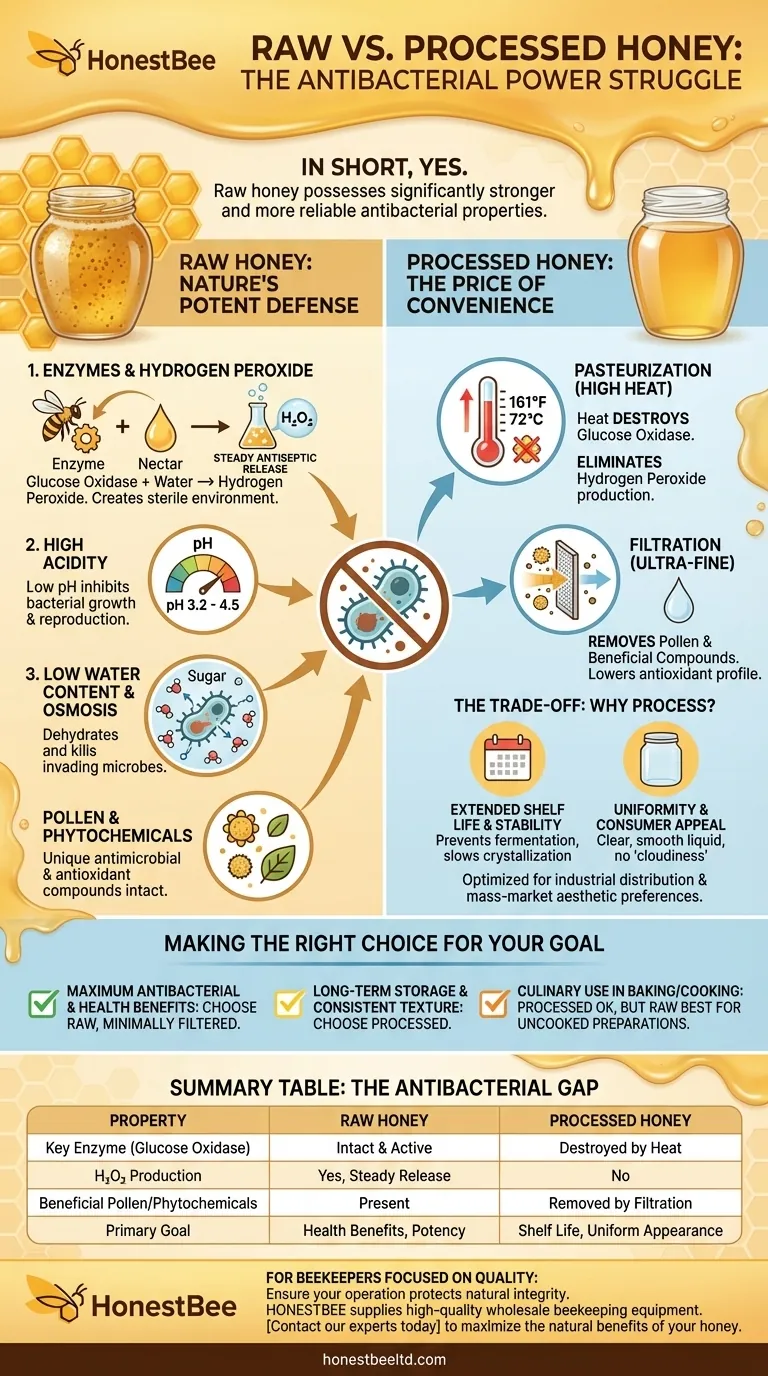
Related Products
- Honeycomb Style Drip Free Honey Dispenser
- Natural Wood Honey Dipper for Tea Coffee and Desserts
- Premium Diamond-Faceted Glass Honey Dispenser
- HONESTBEE 3-Frame Manual Acrylic Honey Extractor
- electric honey extractor honey centrifuge 3 frame honey extractor stainless steel honey frame extractor
People Also Ask
- What are the advantages of using a honey gate? Achieve Clean, Efficient Honey Bottling
- Can we store honey in a stainless steel container? Yes, with the right food-grade choice.
- How do you adjust the flow of honey using a honey gate valve? Master Precision Control for Your Bottling Line
- Is refrigeration necessary for storing honey? Avoid spoiling texture and quality
- What is the purpose of a honey bowl and dipper setup? Achieve Mess-Free, Elegant Honey Dispensing
